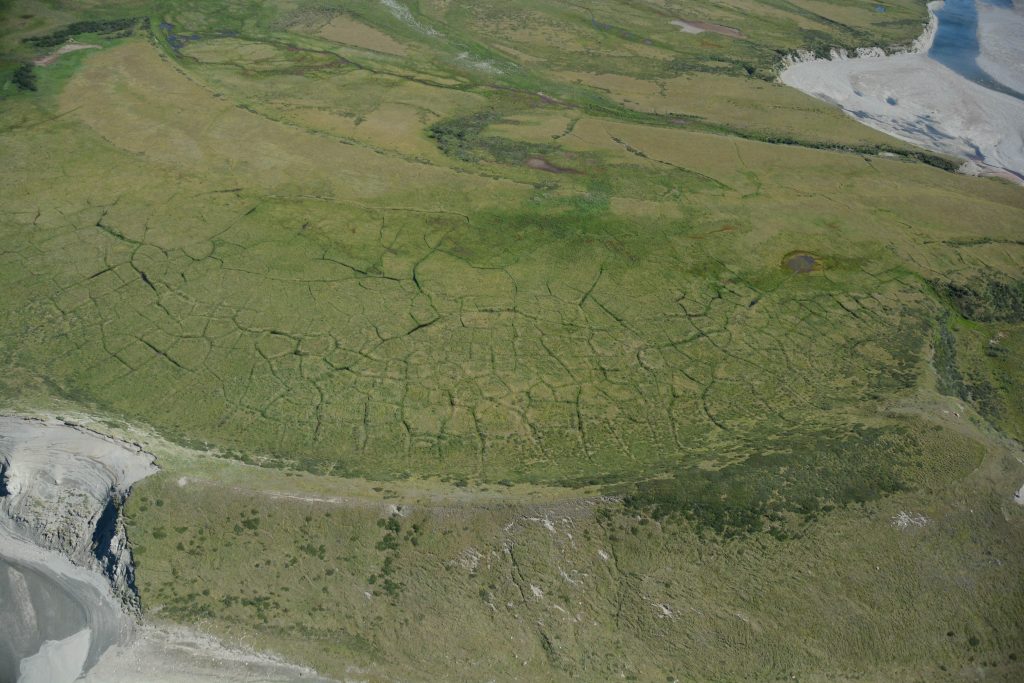Nunavik’s ice wedges show how warmth is changing Arctic landscapes
The changes happening now in Nunavik can offer a preview of what's likely to happen further north.

The top layer of century-old ice wedges in the ground around Salluit in northern Nunavik has started to melt over the past decade.
Ice wedges are made purely of ice, as opposed to permafrost, which is frozen dirt. They’re caused by the seasonal thaw of snow in areas covered in permafrost.
Ice wedges begin to form when permafrost becomes so cold during the winter that it cracks. Later, when temperatures rise and snow at the surface melts, water seeps into these cracks and is then chilled and refrozen by the surrounding permafrost.
As this process repeats itself from year to year, more ice veins can form in the same crack, and the ice wedge grows.
In much of the Canadia Arctic and subarctic, ice wedges help create distinctive polygon-shaped plates. Each polygon has ice wedges forming its boundaries, says Samuel Gagnon, a researcher with Université Laval who studies these formations.
They can be several meters deep and more than a meter wide on the surface, Gagnon said.
In lower temperatures, new stages of an ice wedge, or upgrowth, can grow into the layer of ground that sits above the ice wedge. This ground, known as the active layer, thaws in the summer and freezes in the winter.
Following a long, hot summer, this active layer would be thicker, as more of the ground thaws.
For his work, alongside Michel Allard, a geomorphology professor at Laval, Gagnon looked at 16 sites within the Narsajuaq valley outside Salluit. He presented some of their findings on ice wedge change in Nunavik at the ArcticNet Annual Scientific Meeting in Halifax on Dec. 3.
Ice wedges across the Arctic are centuries old. But depending on the climate, they can go into periods of dormancy.
“In the first half of the 20th Century, ice wedges were dormant because it wasn’t cool enough to cause thermal contraction,” Gagnon said.
A cooling period began in 1946 and reactivated the ice wedges as thermal contraction cracks again formed. Over this period, they also saw upgrowth of ice wedges into the active layer.
And this continued from 1946 to 1992.
What’s particularly interesting about the area around Salluit is that it only started experiencing rapid warming in the early 1990s. From 1993 to the current day, the mean annual air temperature rose from -10 C to -6 C.
And, between 1989 and 1991, ice wedges in this area were studied extensively, Gagnon said.
That allows researchers like him to compare the change in ice wedges before and after a recognized period of warming.
During Allard’s study of these ice wedges in 1991, 94 percent showed signs of recent growth. When they went back in 2017, only 13 percent showed this.
By 1998, the active layer had melted through upgrowth and reached what’s called the main stage of the ice wedge — the widest and oldest area of ice, Gagnon said.
Between 2006 and 2010, the top layer of those main stages had started to melt.
“It’s warmer, so the active layer becomes thicker, goes deeper and melts that top layer of ice,” said Gagnon.
“It took less than a decade to melt what took centuries to form.”
When ice wedges melt, a void is left that could have major impacts on the surface. The likely result is ground collapse, which, Gagnon said, could also create a sort of feedback loop where the ice wedge is more exposed and so degrades more rapidly.
Between 1998 and 2010, though the active layer continued to deepen in their study area, winter temperatures were also low enough to continue to cause cracking underground.
So, while the ice wedges melted from the top, they still grew in width.
After 2010, lower temperatures have led to a thinner active layer above the ice wedges, and no melting has occurred.
What they’ve observed around Narsajuaq, Gagnon said, has implications for other areas.
Just south of Salluit, it’s too warm to have thermal contractions that form and add to ice wedges. But north of here, the ground is still cracking and ice wedges are actively growing.
Salluit is on the precipice, seeing the change that temperature fluctuation brings.
“Salluit’s location gives a good indication of what will happen in the future, farther north,” said Gagnon.